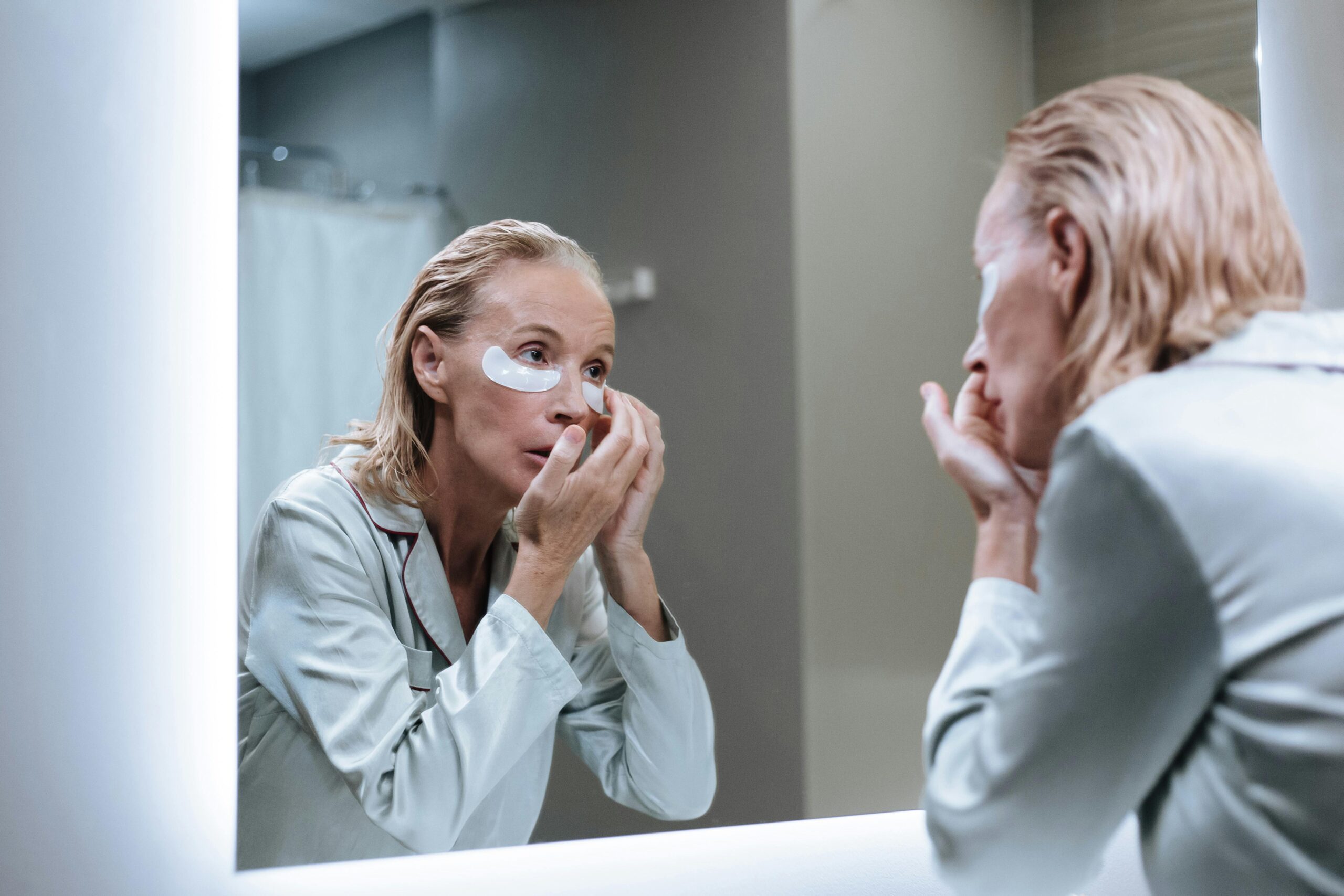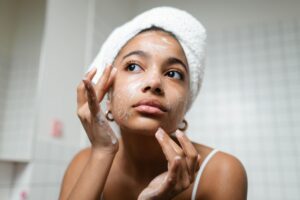Everything You Need To Know About Glycerin In Skin Care

Any beauty lover or skin care fanatic gets hyped up by the newest skin care ingredients. However, that doesn’t mean that the tried-and-true ingredients shouldn’t get their time in the limelight too. It’s important to know what you’re exposing your skin to, no matter how familiar the ingredient might be. With this in mind, an often overlooked ingredient in skin care products is glycerin. When you think moisture, your mind may wander to hyaluronic acid, shea butter, or the likes. Yet, glycerin is slowly coming out of the shadows as a slightly less glamorous but super effective alternative.
The popular yet often unnoticed ingredient is everywhere; in hair products, makeup, soaps, food products, moisturizers, and more. As with most ingredients in cosmetics, there are mixed opinions on the safety and effectiveness of glycerin despite its popularity. So, is it all it’s made out to be? Let’s take a deeper dive into the numerous benefits and uses of this tried-and-true ingredient. But first, we need to discover: what is glycerin and what exactly is it made of?
What Is Glycerin? What Is Glycerin Made Of?
If you’ve ever wondered “what is vegetable glycerin?” you’ve come to the right place. Glycerin is a naturally occurring alcohol compound from plants, animals, and human tissues. It is commercially sold as a thick, sweet-tasting, colorless, and odorless liquid that is typically sourced from plants, such as soybeans or palm, from animal-derived tallow, or manufactured synthetically.
This ingredient is popularly used in vegan cosmetic products and in food products. You can also purchase glycerin gel or glycerin oil in its pure form to use in a variety of DIY cosmetic recipes. This emollient isn’t only an ingredient in cosmetics, it’s also sold in its pure form online and in your local drugstore. Look out for pure glycerin or pure vegetable glycerin to ensure that you’re giving your DIY the attention it deserves without any of the nasties or fillers.
What Is Glycerin Used For? Glycerin Uses Explained

Shampoo often contains glycerin.
Glycerin is a popular ingredient for good reason. You can find it in soaps, shampoos, food products, dairy-based drinks, hair color, makeup, dishwater detergent, toothpaste, shaving cream, gelatin, antifreeze, and more. You will probably find on the ingredient list in at least one product that you own.
It has numerous uses but is most popular as a moisturizing agent. Glycerin is a well-known humectant (skin moisturizer) and is frequently included in moisturizing creams and lotions. It draws moisture from the air around us and helps retain that moisture in our skin, strengthening the skin’s moisture barrier and keeping skin hydrated. In a 2001 study by Loden and Wessman, participants who used a cream containing 20% glycerin experienced a significant increase in skin hydration after just ten days. It’s non-toxic and non-comedogenic, meaning that it does not block pores and can be used on acne-prone skin without causing breakouts.
Glycerin also moisturizes lips and helps get rid of dead skin. To use it on your lips, mix pure glycerin with rose water in equal amounts, and apply to your lips once a day. This combats dry lips and keeps your lips soft and supple. What’s more, when you combine glycerin with rosewater, it becomes a refreshing and hydrating toner for your face. You can apply this DIY rosewater and glycerin toner to your face after cleansing. Alternatively, can use it as a setting mist to help keep your makeup in place.
In addition to working as an effective skin moisturizer, Glycerin also contains antimicrobial and antiviral properties. In fact, a 2012 study by Stout and McKessor showed that glycerin is effective at treating wounds and fading scars. However, they warn that in high concentrations it can dehydrate the skin. For this reason, only use diluted pure glycerin on wounds or burns.
Glycerol Vs Glycerin Explained
Ah, the good old glycerol vs glycerin debate. To cut to the chase, glycerol and glycerin are both names for the same compound. It’s confusing at the best of times, but let’s try to break it down. Glycerol is the pure form and glycerin is the commercial name for a sample that contains up to 95% glycerol. Glycerol is generally an ingredient for medical purposes where 100% pure glycerin is in use. Meanwhile, glycerin is an ingredient for everyday cosmetic and food products.
You will find that people often use the terms interchangeably. However, in most cases, especially when it comes to beauty DIYs, people are looking for glycerin rather than glycerol. It’s not that you want to use the less pure version but you simply don’t need such a concentrated amount when it comes to your skincare. It’s simply too potent to go for full-blown glycerol unless you’re into professional product development.
Glycerin For Skin: Glycerin In Skin Care

Moisturizing skin.
Glycerin is an incredibly popular ingredient in skin care products. But is it good for your skin? The short answer is yes. It’s skin benefits are numerous. It treats dry skin and acts as a humectant, stopping the moisture in your skin from evaporating. Glycerin can also help to fight skin diseases such as psoriasis, and aid in the treatment of acne. It maintains the skin’s pH levels, increases skin elasticity, and delays signs of aging. What is more, it strengthens the skin’s moisture barrier and protects the skin from the environment. Needless to say, glycerin is an ideal ingredient to use on your face.
However, it is important to note that using glycerin for the face and skin in its pure form can be dehydrating and harsh on skin. For this reason, it’s typically combined with other ingredients in products to balance it out. You usually use it in concentrations of 5% or less and mixed with distilled water and other emollients and oils in cosmetic products to maximize its effectiveness. Although it’sis generally safe to use on all skin types, it can cause an allergic reaction in some instances or may cause skin irritation. For this reason, it is best to test patch products containing glycerin on your skin first before applying it to a large area of your skin.
Vegetable Glycerin For Hair

Woman with silky hair.
Glycerin’s hydrating properties aren’t only good for your skin, they’re also incredibly moisturizing for your hair. Just like with your skin, glycerin also works as a humectant when it comes to your hair. For this reason, this emollient is a highly common ingredient in a variety of natural hair care products. You can find it in shampoos, conditioners, oils, serums, and masks. Often glycerin is one of the top ingredients on the list in a product. It actively works to help de-frizz your hair, leaving it soft and smooth. It also helps to repair damaged hair and prevent hair breakages. This can encourage healthy hair growth.
If you don’t feel like splurging on high-end hair care products containing glycerin, you can enjoy the benefits by creating your own DIY leave-in conditioner or mask. You can purchase pure vegetable glycerin at your local drugstore if you don’t have it at home. It dissolves easily into water, making it the ideal ingredient for a DIY hair care product. The bottom line is that if you’re not sure where to start with a highly hydrating beauty DIY, glycerin is an easy and safe go-to.
Is Glycerin Vegan?
When it comes to vegan skincare, there are plenty of options to go around. However, it’s important to do your research before you go ahead with new ingredients, as you don’t want to accidentally expose your body to something you’d rather not! With this in mind, it’s important to know where this powerful emollient comes from.
You produce vegetable glycerin by heating triglyceride-rich vegetable fats under pressure until the glycerin splits away from the fatty acid. It is then absorbed by water and this version is vegan. However, the animal-derived version, which is produced by heating tallow mixed with water until the mixture is thick, is not vegan. If you are vegan, do your research to ensure that the glycerin in the products you are using is plant-sourced and vegan.
Conclusion
Trending products like hyaluronic acid and the likes have been stealing all the limelight lately when it comes to natural skin moisturizers. It is great to discover a natural ingredient that takes you right back to basics in your quest for ultimate hydration. That’s where glycerin comes in. As we have seen, it acts as an effective skin moisturizer as well as benefiting the skin in other ways. This super-emollient ingredient is not new. In fact, it’s hands down what we love to call “an oldie-but-a-goodie, and you probably already own cosmetic products that have this on the label.
However, it’s always great to learn more about the ingredients we use on our skin. It’s also good to know what ingredient to look for the next time you purchase cosmetic products. Alternatively, you can purchase pure glycerin to use in your own DIY beauty products. There’s no need to wait for the first wrinkle’s appearance to try to save your skin. Moisturizing your skin daily, even when it’s smooth, is the best pre-emptive way to delay signs of aging and keep you looking and feeling healthy!



